Washington County, WI – Over the last 15 years, Dave Bohn has been writing down memories of his childhood, growing up on the family farm just south of West Bend on Hwy P. He hopes his writings will preserve the often-overlooked stories of ordinary farmers and everyday farm life in rural Washington County during the Great Depression through the eyes of a local farm boy.
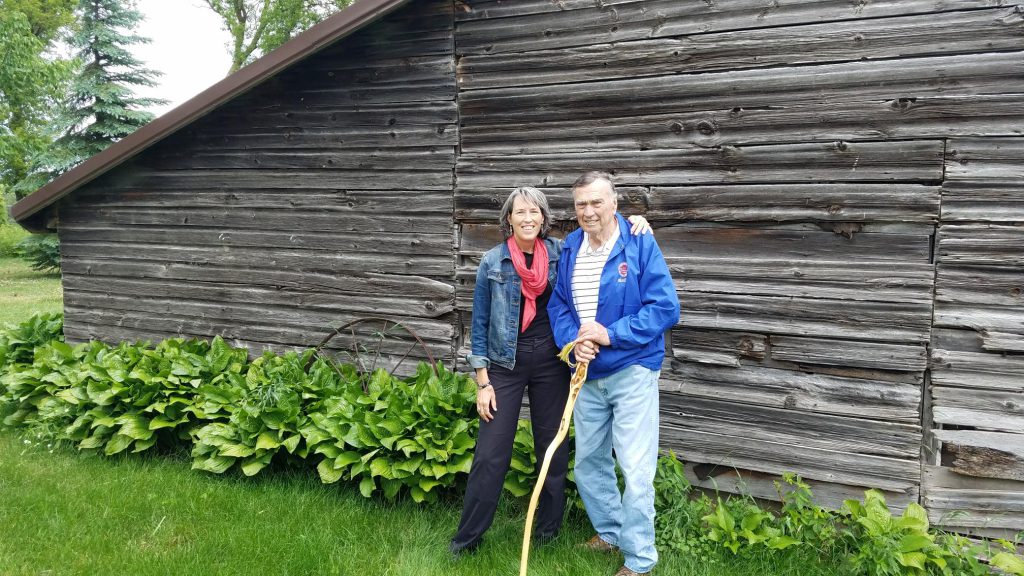
When I was a boy, we raised lots of chickens on our farm to lay eggs. We would sell the eggs by putting a sign on the highway in front of our house that said, “Fresh Eggs for Sale.”
Click HERE to SUBSCRIBE to FREE local news at
Washington County Insider on YouTube
The people would stop and buy some for their breakfast. We had lots of regular customers. Usually, they were people from Milwaukee who were going to the area lakes and would drive right past our house on Hwy P.
At the time, working people in factories had a cottage on the lake. The cottage was nothing more than a shack. Nothing fancy, just the basics. It was a roof over your head and an outhouse. There was no indoor plumbing, no electricity. A lot on the lake was affordable back then, not like it is today.
That was most of our customers, not many strangers, and they would buy a week’s supply of eggs from Mom. The cars would drive in the driveway and, as Mom was usually in the kitchen, she would see them from the window and come out to sell them the eggs. Quite often, regular customers would come in the house and Mom would visit with them. You got to know those customers as friends.
We had a lot of chickens, anywhere from 700-1000 chickens at any given time, as our farming operation changed over the years from dairy to more egg laying chickens. When I was a boy, we would get 400 baby chicks from LaPlant Hatchery in March or early April each year. LaPlant Hatchery, which was on the northeast corner of Main Street and Butternut Street in West Bend, would hatch the eggs and sex the chicks so that we only bought hens and never roosters. The hatchery building is no longer there. We did look in Mom’s old ledgers from the farm that my brother Tom still has and found out that 400 baby chicks cost $71.50 in 1940.
We would get 400 one-day-old chicks over a few weeks as Dad didn’t want to get 400 baby chicks all at once. The chicks would be in boxes and Dad probably put them on the trailer and covered them to keep them warm. Dad put the baby chicks in our Brooder House. A Brooder House is for a brood of little chicks right after they are hatched. Our Brooder House was a small building behind our garage near our house. Dad would have to keep an eye on the Brooder House to make sure the heat was adequate because it was spring and it could still get fairly cold. There was a gas brooder stove to warm the chicks when they arrived, which was in March or early April each year. In any case, they all arrived at our farm and were put in the Brooder House for about six weeks.
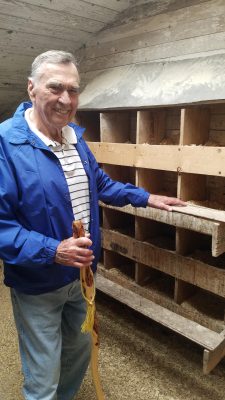
Then the chicks were transferred to a larger house that we called the Rabbit House. When I was about four years old, Dad bought a house that was used to raise rabbits. He bought it from a Schuster who lived on Schuster Drive in the town of Barton and it had been used for raising rabbits, which he sold to eat. I remember going with Dad. He used a two-wheel trailer he pulled behind the car to bring the Rabbit House home. It had been taken apart sometime before and when Dad got it home, he reconstructed it on its place on our farm. The chickens remained in the Rabbit House until they would start to lay eggs in early fall, around August.
Once the chickens started to lay eggs, they were transferred to the Hen House. Later, as the chicken operation grew, Dad and Mom used part of the lower barn for chickens along with the 12 or so cows. The Hen House was insulated with a woven wire ceiling and about eight inches of straw laid on top of the wire. The side walls were insulated the same way with the straw and wire, but the wire was covered with wood to prevent the straw insulation from sagging. The Hen House was not heated because, with the straw insulation, the 200-300 chickens inside gave off enough heat to keep it warm through the winter. The Hen House was crowded with chickens in the winter.
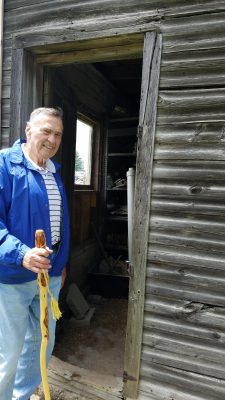
In the summer, the chickens were not fenced in, so they could roam around the farm yard if they wished, but they never went very far. Now, some of the chickens didn’t go in their Hen House to sleep. Some of them would sleep in the apple trees we had planted around the farmyard. They would sit on a branch and put their heads under their wings and go to sleep for the night. The wings fit against the body so when they sleep, you can’t see their beaks or their heads. They sleep in the trees so the foxes and other wild animals can’t get them. These wild animals are out looking for a chicken dinner at night and the ones that would eat chickens cannot climb trees. So, chickens are safe when they sleep in a tree.
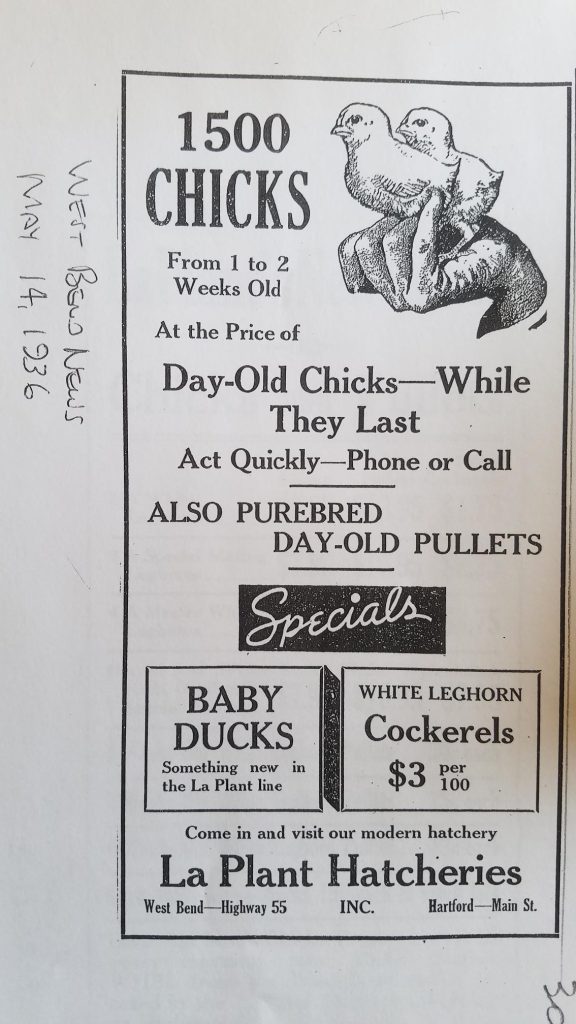
The chickens that slept in the Hen House slept on a roost which was a 2 x 2-inch strip of wood that ran the entire length of the Hen House. There was maybe 18 inches between each roost. There were four or five of these roosts that were staggered up, following the pitch of the roof. The roost looked somewhat like a ladder.
At night, a line of chickens would sit on these roosts, one next to the other as close together as possible and one behind the other also as close together as possible. The roosts were on the pitched side of the roof of the Hen House and the nest boxes, where the chickens laid their eggs, were on the flat side of the Hen House.
About 10 inches below the roost and about three feet off the ground, there was a platform that the chicken droppings would land on. The platform under the roost had to be cleaned every day as there were lots of droppings on the roost deck.
Since Tom and I were the two oldest boys, it was our job to clean it every morning before school started. Each boy would take a day, so it would be my job every other day. We had a hoe we used to scrape the chicken manure forward. Then, we placed the manure in a bucket and dumped it on the manure spreader outside. We had a Gehl manure spreader from the 1930’s. One time a week, the straw on the entire floor of the Hen House had to be taken out and replaced with new straw. That was also a job for me and my brother Tom.
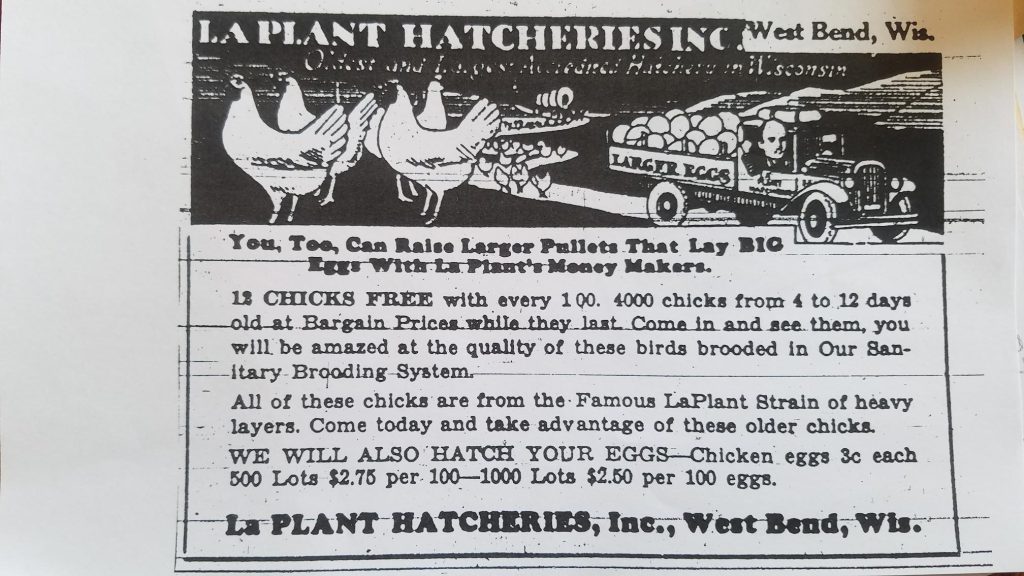
The chickens ate grain we grew in our fields. Wheat and oats were ground up into a mash with corn sometimes mixed in. Tom and I would just spread the grain on the ground for them to eat. Everything from feeding to cleaning to taking the eggs to Mom was the kids’ job.
Now, chickens do not have good bathroom habits and just go wherever they are. In the summertime, we were always barefoot and didn’t look, or we didn’t care, where we stepped. We had our baseball field where the chickens would eat their food right off the ground. We would often make foot contact with their droppings. We would just find some grass and rub our feet till we thought they were clean enough and go on with the game until it would happen again.
Sometimes, the ball would roll into this little problem. This called for a hands-on cleaning. It would happen quite often, so it just became part of the game. Even though we had to deal with the chicken droppings, the chickens knew they had to stay out of the way when we were playing baseball and they did.
The Hen House had about 20 divided cubes, about 10 inches x 10 inches, where the chickens would lay their eggs about every third day. The eggs were almost always in the nests. The chickens just knew to lay them there. There was a layer of straw in these nest boxes and the chickens would lay one egg at a time.
The chickens thought these nests were a good place to raise their young, but we always took the eggs, so they kept laying more. Chickens aren’t too smart. Once in a while, an egg may have been on the floor, but that was very rare.
Most of the time in summer, the chickens would go in the nest boxes to lay their eggs but sometimes they would lay eggs in the bushes outside. They would hide them from us because they’ll have little chicks if you don’t find them and the mother sits on the eggs. In two or three weeks the eggs turn into little chicks. We would find the fuzzy little birds when the mother would bring them out from their hiding place to feed them with the other chickens. If we did find the eggs early enough, we would eat those ourselves because they would spoil faster.
My brother Tom and I gathered the eggs twice a day, in the morning and in the evening. With about 300 laying chickens, we maybe got 100-125 eggs each day when they were laying good. We put them in a pail and brought them to the house. Tom and I would inspect each egg and wash them if necessary.
About one in every 20 eggs needed to be washed. We then put the eggs in the basement where it was cool. We put them in big egg crates made especially for eggs, holding about 30 dozen eggs. There were about four or five layers of eggs with cardboard in between. The cardboard was shaped like the eggs so they wouldn’t roll around. This was just for storage. The eggs would keep about three weeks in the basement without refrigeration. After that, they were questionable.
Mom would sell the eggs to people driving by on the highway with a sign out in front of our house that read “Fresh Eggs for Sale.” In 1941, she sold them for anywhere between 25 cents and 43 cents a dozen. But I do remember that she would sell them for as much as 70 cents a dozen, depending on the egg market and the year. Egg prices could vary a lot during the year because sometimes the chickens would lay more eggs than at other times and sometimes the demand was greater.
Because we lived on Hwy 45 (now Hwy P), people would be on their way to their cottages on the lakes of the area. There were a lot of cars on the road for this time. People liked fresh eggs off the farm better than eggs from the store, so sales were always pretty good.
People had their own egg cartons they would bring, and we would fill them with fresh eggs. So, in the summertime, we never had an excess of eggs, as people would stop in to buy them. If Mom did have too many eggs, she would take them to Hoge & Gumms in Jackson and other stores in West Bend to sell the eggs, but for a lot less money than if she had sold them herself. That didn’t happen too often, mostly in winter when the chickens would lay more eggs and there was less traffic on our road, so direct sales weren’t as good.
Click HERE to read Dave Bohn’s article: Remembering the corner grocery
At about a year and a half, the chickens would still lay eggs, but not as many, so Dad would sell them each October before the egg laying tapered. That way, he got more money for them as other farmers wanted chickens that laid eggs. Dad would sell them for about $1.00-$1.50 a chicken, depending on the year. The 1½-year-old chickens were pretty good layers for about another year. Most of the people who bought them were repeat customers so they would come back every few years to buy new chickens. The chicks from the spring would then be our egg producers for the next year. This cycle was the same every year.
Mom and Dad stopped selling eggs when Tom and I went into the service because there was no one there to help do the work anymore. My sister Mary Ann became a teacher and then got married and my younger brother Jerry went to High School, so he wasn’t around as much to help. They sold the chickens just before I went into the Army and I was glad to see them go.











